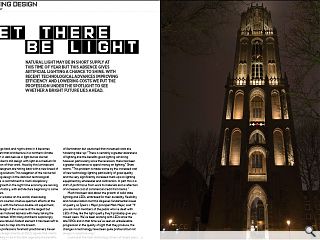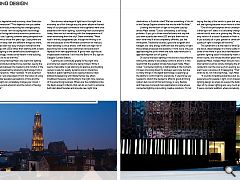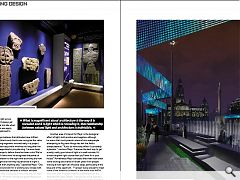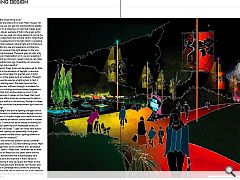Lighting Design
15 Jan 2015
Natural light may be in short supply at this time of year but this absence gives artificial lighting a chance to shine. With recent technological advances improving efficiency and lowering costs we put the profession under the spotlight to see whether a bright future lies ahead.
As the clocks go back and nights draw in it becomes starkly apparent that architecture in a northern climate exists as much in darkness as in light but as diurnal creatures architects still design with light as a medium for the appreciation of their work. Irked by this luminescent bias lighting designers are hitting back with a new breed of photon bathing solutions This relegation of the nocturnal has left lighting design in the dark but technological developments, a commitment to multi-disciplinary working and growth in the night time economy are serving to reverse this history, with architecture beginning to come alive after hours.Light is our window on the world, showcasing everything from counter intuitive quantum effects at the smallest scales, with the famous double-slit experiment, to the grand design of the universe at the largest but this ubiquity has fostered laziness with many taking the medium for granted. With many architects surprisingly slow to embrace nature’s fastest element it has been left to lighting designers to step into the breach.
One of the professions foremost practitioners, Kevan Shaw, lighting design director at KSLD, agrees that clients are now less likely to be in the dark regarding the benefits of illumination but cautioned that increased costs are hindering take-up: “There is certainly a greater awareness of lighting and the benefits good lighting can bring however, particularly since the recession, there has been a greater reluctance to spend money on lighting,” Shaw warns. “This problem is made worse by the increased cost of new technology lighting particularly of good quality and the very significantly increased mark ups on lighting equipment by wholesaler and contractors. In part this is a shift of profit focus from work to materials and a reflection of increased cost of commercial credit from banks.”
Much has been said about the growth of solid state lighting and LEDs, embraced for their durability, flexibility and miniaturisation but this disguises fundamental issues of quality, as Speirs + Major principal Mark Major, said: “If you ask most members of the public who’ve dealt with LEDs if they like the light quality they’ll probably give you mixed views. We’ve been working with LEDs since the late 1990s and in that time we’ve seen an unbelievable progression in the quality of light that they produce, the changes in technology have been quite profound but not always in a positive way.”
Looking at the main technology drivers of recent years, from science to legislation and economy, does Shaw also see a lighting revolution? “This depends how you define a revolution. Technically everything has changed partly due to different (note I am not saying new) technology but also due to the legislative and economic pressure to reduce energy use. Lighting schemes being designed now are not the same as those five years ago. Sadly there are surprisingly few really new and different things out there, the industry has been too busy trying to reinvent all the same old things with LEDs rather than starting with a clean sheet and designing to the benefits and advantages of the new technology. Innate conservatism in the building business has a lot to do with this.”
An architect by training Major only went into lighting because he had always wanted to be a painter, seeing the obvious parallels between the mediums and mindful of the opportunities presented by advancing technology from a mid-1980s perspective. Major recalled: “It was a perfect blend of things I was interested in from the notion of using a medium to alter people’s perceptions of time and the way in which light can completely change your mood. I love architecture and urbanism and the notion of having both was great.”
One obvious advantage of light lies in the night time economy, as a flick through any old photo album will attest many of our principal commercial thoroughfares were once bedecked with neon lighting, outshining their counterparts today. Have we lost something with the disappearance of neon advertising from the city? Shaw answered: “Neon hasn’t entirely disappeared yet, though the writing is on the wall because of the Minimata convention on mercury. Neon bending is a true artistic craft that is at high risk of becoming lost as the older craftsmen retire and aren’t replaced with new apprentices. A good neon sign has an irreplaceable character. I still miss the Barrs Irn Bru sign on Glasgow Central Station.
“Lighting can contribute greatly to the night time economy but opportunities are being missed. While it seems impossible to get planning to approve and building owners to pay for quality dynamic and or interactive facade or public lighting we are seeing massive video billboards appearing with Blade Runner like effect. Doubtless these are contributing to the night time revenue of the advertising business. Where are the installations like the Spots project in Berlin, that can do so much to enhance both dull dated facades and provide new night time destinations in Scottish cities? We had something of this ilk in the George Square scheme that we did with McAslan.”
Likening the medium of light to the paint used by artists Major stated: “Colour consistency is still a big problem. If you go to three manufacturers and say that you want a particular white LED and put them next to each other they’ll all be completely different, just like white paint. Traditional sources, good old tungsten and halogen, are very energy inefficient but the quality of light those lamps produced was beautiful. I think we’re only just approaching the point where the solid state revolution is approaching that sort of quality.”
Of course the best lighting in the world is less effective without the ability to accurately control it and it is in this regard that the greatest strides have been made. Major noted: ”Connected lighting is fashionable at the moment, it’s been knocking about for donkeys years now but like so many things in life digital technology is opening up the ability to control light to everybody. It used to be you needed to stretch the budget to afford a good dimming system but now all of this technology is very flexible and there are more and more applications online where connected lighting is providing creative solutions. I’m not saying the day of the switch is gone but very quickly we will see lighting become much more of a lifestyle thing.
“One of the philosophies which underpins our practice is that light isn’t static it is constantly changing like the natural world, even on a gloomy day. We might normally only notice it if a cloud if it passes in front of the sun, but if you actually sit in your garden or street and watch the quality of light it changes all the time.”
This dynamism is at the heart of what Speirs + Major are about, albeit adopted in a more subtle manner than some of the more in your face manifestations. “For us dynamic lighting doesn’t necessarily mean something which is pink, one minute and then green the next”, explained Major. Instead Major favours more subtle interventions such as slowly changing the ambience of a restaurant over the course of an evening such that diners aren’t even conscious of it happening. “That’s the art of what we do, not noticing things,” says Major.
“It sounds incredibly pretentious but we create experiences for people in light. A lot of people think about lighting design as where do we put the bulbs? In the early days of my career lighting was very much an afterthought. It was a cosmetic addition where somebody applied a lick of paint or light across a façade. They’d always get you involved far too late when all you could do was apply something as opposed to integrating it.”
Happily Major believes that attitudes have shifted, noting that architects and clients now recognise the value in getting lighting engineers involved early in a project. “Quite often these days we’re involved not long after the architect gets appointed in pre-planning. I’ve even been appointed on projects before there has been a site! We’ve had a couple of clients who’ve recognised the power of their brand in relation to the night time economy and how they look at night and how they’re perceived at night is more important than anything else,” explained Major. “One of the things we’re known for is working very closely with the architect, landscape designer or interior designer. Quite often we’ll say ‘if you just did this with the roof then this will happen’. We have a strong but quiet influence on the architecture itself.”
Another area of interest for Major is the biological effect of light, both positive and negative, although he warns that much pseudo-science from salespeople attempting to flog new fittings has lent the field a disreputable air. “If you do notice any effect it’s probably a placebo ,” cautions Major, “because the best way to get a really, really good dose of light is to walk outside; It’s a much brighter light source than you’ll ever fit in your house!” Nonetheless Major concedes that there have been some exciting discoveries in recent years from people looking at how light can influence sleep, particularly at the blue end of the spectrum. “I’ve been lucky enough to meet some of the foremost scientists in the world from NASA who work with circadian rhythms of astronauts on the International Space Station. They say too much exposure to blue light from your laptop or iPad in bed late at night is probably not the wisest thing to do.”
Digging into the nature of his work Major mused: “At its most extreme you can get into a philosophical debate about whether it’s architecture or light that makes great buildings. The classic example of that is the great gothic cathedrals, when you walk into those spaces of course the architecture is magnificent but actually what’s magnificent is the way it’s revealed and it’s the light which is revealing it, that relationship between natural light and architecture is indivisible. We only see and experience architecture through light so however that light appears is the way you’ll experience the space. The same goes at night only we are placing an interpretation on it, we are revealing it in a way in which we choose to reveal it and we can make something beautiful look ugly (hopefully not) and even make ugly things look beautiful.”
One area which Shaw thinks can be improved for little additional cost is the utilisation of daylight, a resource which continues to be taken for granted even in light-starved corners of the globe such as Scotland: “Daylight can be and should be used as a lighting tool, in fact it should be the starting point. We really have lost the thinking that ensures sufficient daylight is available for practical tasks in buildings and have allowed regulations to be created that limit window areas so much in the interests of improved U values on the cheap, that much new housing and office stock are condemned to electric lighting all day as well as in the evening. Daylight is cheap and healthy and should be the predominant light source in all new buildings.
“Faking daylight and diurnal lighting changes can be beneficial particularly in situations where daylight cannot be present, cores in hospital single room ward blocks are a striking example as are reactor control rooms in nuclear power stations. It should not be an excuse or remedy for poor (or greedy!) planning with inadequate access to daylight.” Shaw concludes: “ Light can rarely save a poor building but poor lighting can potentially ruin a great one (see the current horrible colour lighting scheme on Edinburgh Castle for instance!)”
Mindful of the continued shadow cast by Jonathan, who sadly passed away in 2012 after battling cancer, Major added: “The approach which Jonathan and I developed still underpins Speirs + Major now. Jonathan had to retire in 2010 because of illness but four years down the line we wanted to demonstrate that the philosophy we’d developed was alive and well and in that’s sense his legacy is still strong. It may say Speirs and Major on the letterhead but actually Keith Bradshaw, Iain Ruxton and Andrew Howis in Edinburgh and London are producing ground breaking work. We’ve matured into a very different practice now and are stronger than we were four years ago when John left us.”iors turns that skin deep bias inside out, completing the picture for the first time.
|
|
Read next: Glasgow Interiors
Read previous: Holyrood South
Back to January 2015
Browse Features Archive
Search
News
For more news from the industry visit our News section.
Features & Reports
For more information from the industry visit our Features & Reports section.






